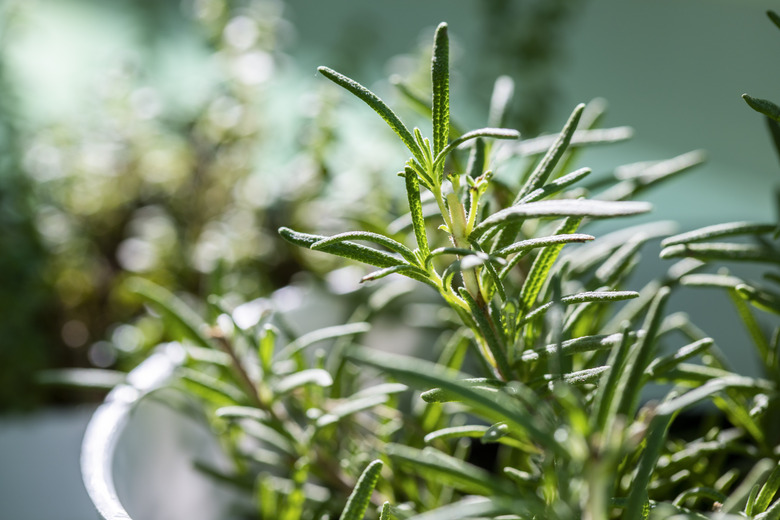How To Treat Powdery Mildew On Rosemary Leaves
We may receive a commission on purchases made from links.
A Mediterranean native, rosemary (Salvia rosmarinus) will grace an outdoor herb garden in U.S. Department of Agriculture plant hardiness zones 7 through 11, but you can also grow it in a pot and bring it indoors for winter in cooler climates. Although easy to grow, this fragrant herb is susceptible to several plant diseases, including powdery mildew. Luckily, several spray solutions help get rid of powdery mildew disease on a rosemary.
Warning
Although natural powdery mildew treatments aren't generally toxic to people or animals, any solution can irritate your skin or eyes with direct contact. Reduce your risk of exposure by wearing protective eyewear, waterproof gloves, a respirator mask, long sleeves, pants, and shoes with socks when mixing and spraying fungicidal solutions.
Effects of Powdery Mildew on Rosemary Leaves
Effects of Powdery Mildew on Rosemary Leaves
Powdery mildew on rosemary leaves typically starts out as small, dusty, white spots that enlarge to cover entire plant surfaces with a white to light gray, powdery coating. Once covered, the affected leaves can't photosynthesize efficiently and the plant may experience stunted growth and reduced vigor. Affected foliage sometimes turns yellow, curls, dies and falls from the plant prematurely.
The white powder is a mass of tiny fungal spores, which spread via wind gusts to other plants. Unlike other fungal pathogens, powdery mildew spores require dry plant surfaces to germinate and grow. Standing water kills the spores. Powdery mildew disease thrives during humid weather when cool nights follow warm days. Temperatures falling between 60 and 80 degrees Fahrenheit create the ideal environment for the fungus to infect rosemary plants.
1. Compost Tea Solution
1. Compost Tea Solution
Compost tea solutions have antifungal properties that may control powdery mildew fungi. Commercial compost tea kits exist, but you can easily make your own:
- Combine 1 part aged compost with 5 or 6 parts water. (Finished compost containing a little manure seems to work most effectively.)
- Let the solution sit for seven to 14 days before you strain it.
- Slowly add water until the solution reaches the color of brewed tea.
- Spray the final solution on your plants every 14 days throughout the growing season.
2. Baking Soda Mixture
2. Baking Soda Mixture
A baking soda solution may also help protect plants from powdery mildew pathogens as well as get rid of existing fungi. Baking soda works by changing the pH levels of leaf surfaces so they are inhospitable to the fungi.
- Mix 1 1/2 tablespoons of baking soda and 3 tablespoons of lightweight horticultural oil in 1 gallon of water.
- Treat plants once a week, taking care to thoroughly coat the tops and undersides of leaves.
Tip
Although effective, the solution can leave behind a powdery, white film that looks a lot like the disease itself. In addition, some plants are sensitive to the solution, so test it on a small section of leaves first. If the solution doesn't cause any damage after 24 hours, treat the entire rosemary plant.
3. Neem Oil Remedy
3. Neem Oil Remedy
Spraying neem oil solutions on a rosemary plant with a moderate to heavy infection helps eradicate powdery mildew on rosemary leaves and prevent fungal development.
- Mix the neem oil according to label directions and pour the solution in a small spray bottle.
- Coat the tops and undersides of leaves until they glisten with moisture.
- Repeat applications every seven to 14 days until the disease symptoms disappear.
Avoid spraying plants with neem oil when temperatures reach higher than 90 F or to rosemary plants suffering from water stress.
